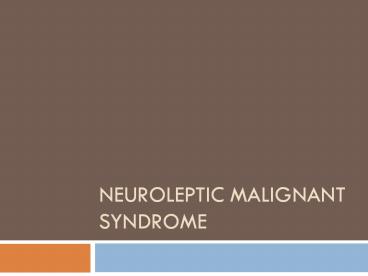neuroleptic - PowerPoint PPT Presentation
Title:
neuroleptic
Description:
neuroleptic malignant syndrome – PowerPoint PPT presentation
Number of Views:139
Title: neuroleptic
1
Neuroleptic Malignant Syndrome
2
Patho physiology
- Relative lack of dopamine
- dopamine receptor blockade
- inadequate dopamine production
3
Patho physiology
- Supporting evidence
- Neuroleptic drugs block dopamine receptors
- occurs with other dopamine blocking drugs
- occurs on sudden withdrawal of antiparkinsonian
therapy - responds to dopamine agonists
4
Clinical features
- Essential
- recent or current therapy with dopamine blocking
drug - Neuroleptic
- other drug eg metoclopramide
- recently stopped a dopamine agonist eg L-dopa
5
Autonomic dysfunction
- 2 or more of
- hypertension or labile BP
- systolic gt 30 mmHg above baseline or
- diastolic gt 20 mmHg above baseline
- variability of gt 30 mmHg systolic or gt20 mmHg
diastolic between readings - tachycardia (pulse gt 30 bpm above baseline)
- diaphoresis (intense perspiring)
- incontinence
- tachypnoea (gt 25 breaths/min)
6
Extra pyramidal features
- 2 or more of
- Bradykinesia (Slow movement)
- lead-pipe or cogwheel rigidity
- resting tremor
- Sialorrhoea (excessive salivation)
- Dysphagia (difficulty in swallowing)
- Dysarthria / Mutism ( inability or unwillingness
to speak)
7
Minor features
- Support but are not required for diagnosis
- rise in creatinine kinase
- altered sensorium/delirium
- leucocytosis gt 15,000x109/L
- low serum iron
- Help confirm diagnosis
- therapeutic response to dopamine agonist
8
Risk factors
- Incidence 1 (0.023.23)
- Pre-NMS
- psychomotor agitation
- dehydration
9
Risk factor
- Related to treatment
- Neuroleptic dose in first 24h gt 600 mg of
chlorpromazine - maximum dose in any 24h gt 600 mg of
chlorpromazine - required restraint or seclusion
- Associated
- past ECT
10
Management
- High risk patients
- monitor temperature tds
- monitor blood pressure tds
- record episodes of diaphoresis
- On suspicion
- assess for other medical illness
- FBC(Full blood count), MBA(Microscopic Blood
Analysis), CK( Creatinin Kinase), serum iron - On diagnosis
- withdraw all dopamine blocking drugs
11
Drug therapy
- Bromocriptine
- 2.5 mg q8h up to 5 mg q4h
- continue for 710 days after resolution then
taper over 12 weeks (except depot preparations) - Dantrolene
- 23 mg/kg
- extreme rigidity, very high fever (gt 40oC),
unable to tolerate oral treatment
12
Other therapy
- Benzodiazepines
- to control agitation/delirium
- ECT
- refractory to adequate trial of dopamine
agonist/supportive care - after resolution of acute features
- remain catatonic or
- develop ECT-responsive psychotic features
- suspected acute lethal catatonia
13
Thank you































